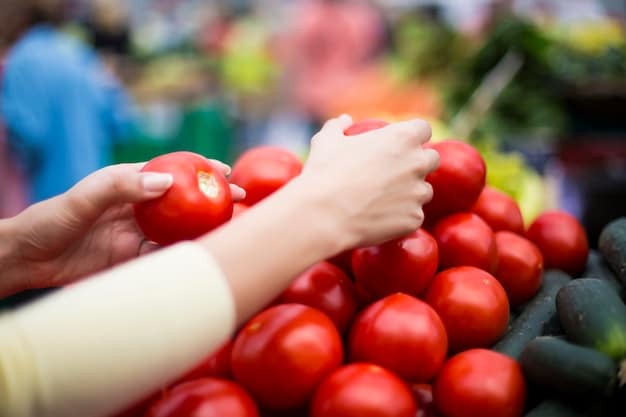Sustainable Food Choices: Local, Seasonal & Organic for Eco-Impact

Adopting sustainable food choices by prioritizing local, seasonal, and organic options is crucial for significantly reducing one’s environmental footprint, fostering community well-being, and supporting more resilient global food systems.
In an era where environmental concerns are at the forefront of global discourse, the choices we make daily hold considerable weight. Among these, our dietary preferences and habits stand out as having a profound impact on the planet. Embracing Sustainable Food Choices: Eat Local, Seasonal, and Organic to Reduce Your Environmental Impact isn’t just a trend; it’s a critical shift towards a more responsible and healthier future for all.
Understanding the Impact of Our Food System
Our modern food system, while providing unprecedented access to a vast array of products, comes with a significant environmental cost. From field to fork, every stage of food production, distribution, and consumption contributes to various ecological challenges. This intricate web involves complex supply chains, intensive agricultural practices, and considerable energy demands, all of which leave a noticeable mark on our planet.
The globalized nature of food production means that items can travel thousands of miles to reach our plates. This extensive transportation network relies heavily on fossil fuels, leading to substantial greenhouse gas emissions. Beyond transportation, the methods used in conventional farming often contribute to environmental degradation. Large-scale monocultures, for instance, can deplete soil nutrients and reduce biodiversity, making ecosystems more vulnerable to pests and diseases.
The Hidden Costs of Conventional Agriculture
Conventional agriculture, driven by short-term economic gains, frequently employs practices that are unsustainable in the long run. The extensive use of synthetic pesticides and fertilizers, while boosting yields, can contaminate waterways and harm beneficial insects, including pollinators vital for many crops. These chemicals not only impact the natural environment but can also pose risks to human health. Furthermore, the energy required to produce these inputs adds another layer to the carbon footprint of our food.
Another often overlooked aspect is water usage. Agriculture is one of the largest consumers of freshwater globally, and inefficient irrigation methods can lead to water scarcity, particularly in drought-prone regions. Animal agriculture, in particular, is a significant contributor to greenhouse gas emissions, deforestation, and water pollution, exacerbating climate change and ecological imbalances.
Understanding these impacts is the first step toward making more conscious choices. By recognizing the environmental burden associated with our current food system, we can begin to appreciate the urgency and necessity of transitioning to more sustainable alternatives. This knowledge empowers us to seek out and support practices that nurture both the earth and its inhabitants.
- Greenhouse Gas Emissions: Food production, especially animal agriculture and long-distance transport, contributes significantly to climate change.
- Resource Depletion: Intensive farming drains water resources and degrades soil quality, reducing its fertility over time.
- Biodiversity Loss: Monoculture farming and pesticide use diminish natural habitats and reduce insect and plant diversity.
- Water Pollution: Runoff from farms containing fertilizers and pesticides contaminates rivers, lakes, and oceans, harming aquatic life.
The Benefits of Eating Local
Choosing to eat local means consuming food that has been grown or produced within your geographical region, often within a short distance from your home. This practice is a cornerstone of sustainable eating, offering a multitude of benefits that extend far beyond just the environment. When you purchase food from local farmers and producers, you’re not only getting fresher ingredients but also contributing to a healthier planet and stronger communities.
One of the most obvious environmental advantages of eating local is the significant reduction in food miles. Food that travels shorter distances requires less fuel for transportation, which directly translates to lower greenhouse gas emissions. This reduction helps to mitigate climate change and decrease our collective carbon footprint. Imagine the difference between a tomato grown in a field just a few miles away versus one flown in from another continent; the environmental savings are substantial.

Supporting Local Economies and Community Resilience
The benefits of eating local aren’t solely environmental; they also have strong economic and social dimensions. When you buy from local farmers, your money stays within the community, supporting local businesses and creating jobs. This strengthens the local economy and helps to ensure the viability of family farms, which often struggle to compete with large-scale industrial agriculture. A thriving local food system builds community resilience, making regions less dependent on external supply chains and more capable of weathering economic or environmental disruptions.
Local food is also typically fresher. Because it doesn’t have to endure long transit times, it can be harvested at its peak ripeness, leading to better flavor and higher nutritional value. Unlike produce picked green for shipping, local options often retain more vitamins and minerals. Furthermore, local farmers often employ sustainable practices, such as crop rotation and reduced pesticide use, motivated by a direct connection to the land and their community’s health.
Engaging with local food systems can also lead to a greater understanding of where our food comes from and how it is produced. Farmer’s markets provide opportunities to meet the people who grow your food, ask questions, and learn about agricultural practices. This connection fosters a deeper appreciation for the food on our plates and encourages more mindful consumption. Eating local isn’t just about what you buy; it’s about building relationships and fostering a sense of community around shared values.
- Reduced Carbon Footprint: Less transportation means fewer emissions, directly combating climate change.
- Fresher, More Nutritious Food: Produce harvested at peak ripeness retains maximum flavor and nutritional value.
- Economic Support: Money spent locally circulates within the community, strengthening local businesses and jobs.
- Preservation of Farmland: Supporting local farmers helps keep agricultural land productive and prevents urban sprawl.
Embracing Seasonal Eating for Optimal Impact
Eating seasonally means consuming foods that are naturally ripe and ready for harvest in your region during a particular time of year. This practice is inherently linked to eating locally, as seasonal produce is often what’s available from nearby farms. Beyond the fresh taste and vibrant flavors, choosing seasonal foods offers significant environmental, nutritional, and even economic advantages. It’s a simple yet powerful way to align our diets with natural cycles and reduce our ecological footprint.
From an environmental perspective, seasonal eating drastically reduces the need for energy-intensive interventions. When we buy produce out of season, it often relies on heated greenhouses, long-distance transportation from warmer climates, or extensive cold storage systems to maintain freshness. All these methods consume considerable amounts of energy, contributing to higher carbon emissions. By contrast, seasonal produce ripens naturally under the sun, requiring minimal energetic input.
Nutritional Peak and Economic Benefits
Foods consumed in season are typically at their peak nutritional value. They have had ample time to develop their full spectrum of vitamins, minerals, and antioxidants, delivering the most benefits to our bodies. Non-seasonal produce, often harvested prematurely to facilitate shipping or grown in less optimal conditions, might not offer the same nutrient density. There’s also an undeniable link between seasonal eating and flavor; a strawberry picked in June will taste far superior to one available in December, lacking the natural sweetness and aroma.
Economically, seasonal eating can be more cost-effective. When produce is in season, it’s typically abundant, which drives prices down. Farmers have a surplus, and without the added costs of long-distance transport or artificial growing conditions, these savings can be passed on to the consumer. This makes healthy, sustainable eating more accessible and affordable, encouraging a broader adoption of these practices. It also supports agricultural diversity, as farmers are encouraged to grow a variety of crops throughout the year rather than focusing on a few high-demand items.
Practicing seasonal eating also encourages a deeper connection to nature and the rhythm of the year. It invites us to anticipate and appreciate the bounty each season brings, making meal planning a more engaging and flavorful experience. Regularly visiting farmer’s markets or signing up for a CSA (Community Supported Agriculture) box can be excellent ways to discover what’s in season and explore new ingredients, fostering culinary creativity while supporting sustainable practices.
- Reduced Energy Consumption: Avoids energy-intensive greenhouses and long-distance transport.
- Peak Flavor and Nutrition: Food harvested at optimal ripeness offers the best taste and nutrient profile.
- Lower Costs: Abundant in-season produce is often more affordable due to natural supply.
- Biodiversity Support: Encourages crop rotation and a wider variety of plants grown throughout the year.
The Advantages of Choosing Organic
Opting for organic food means selecting produce and products that have been grown or raised without the use of synthetic pesticides, herbicides, genetically modified organisms (GMOs), or artificial fertilizers. For animal products, it implies that animals are raised without routine antibiotics or growth hormones and have access to the outdoors. The choice of organic food is a significant component of sustainable eating, offering a range of benefits for both the environment and human health.
One of the primary environmental advantages of organic farming is its commitment to soil health. Organic methods focus on natural soil amendments like compost and manure, which improve soil structure, fertility, and water retention. Healthy soil is more resilient to erosion and drought, and it acts as a carbon sink, helping to sequester atmospheric carbon dioxide. This approach contrasts sharply with conventional farming, which often depletes soil health through aggressive tilling and chemical inputs.
Promoting Biodiversity and Reduced Chemical Exposure
Organic agriculture actively promotes biodiversity. By avoiding synthetic pesticides and herbicides, it creates a healthier environment for beneficial insects, birds, and other wildlife. Crop rotation, cover cropping, and the cultivation of diverse plants further enhance ecological balance, making farms more resilient to pests and diseases without relying on harmful chemicals. This holistic approach supports a richer ecosystem within and around agricultural lands.
For human health, choosing organic significantly reduces exposure to pesticide residues. While regulatory bodies set limits for pesticide levels in conventional produce, choosing organic provides an assurance of minimal or no chemical residues on your food. This is particularly important for vulnerable populations like children. Although direct scientific links between pesticide exposure from food and specific health issues are still being researched, many prefer to err on the side of caution.

While organic foods can sometimes be more expensive, the investment often reflects the higher costs of sustainable farming practices, including labor-intensive weeding and pest control methods. However, the long-term benefits in terms of environmental protection, support for biodiversity, and reduced chemical exposure make it a worthwhile consideration for those aiming to reduce their overall environmental impact through food choices. It’s a powerful vote for a food system that works in harmony with nature.
- Improved Soil Health: Organic practices enrich soil, making it more fertile and resilient.
- Enhanced Biodiversity: Absence of synthetic chemicals supports a wider range of plant and animal life.
- Reduced Chemical Exposure: Minimizes the presence of pesticide residues in food.
- Better Water Quality: Prevents chemical runoff into waterways, protecting aquatic ecosystems.
Practical Steps to Incorporate Sustainable Food Choices
Transitioning to more sustainable food choices, focusing on eating local, seasonal, and organic, might seem daunting at first. However, it’s a journey that can be undertaken with practical, manageable steps. Small adjustments to your shopping and cooking habits can collectively make a significant difference in reducing your environmental impact while enjoying fresher, healthier food. The key is to start somewhere and build on your efforts over time, rather than aiming for perfection overnight.
One of the most effective starting points is to frequent your local farmer’s market. These markets are hubs for local and seasonal produce, allowing you to directly connect with farmers and learn about their growing practices. Many markets also offer organic options, making it a one-stop shop for all three sustainable principles. Visiting regularly helps you familiarize yourself with what’s in season in your area, guiding your purchases naturally.
Meal Planning and Smart Shopping
Strategic meal planning can greatly aid in adopting sustainable food habits. By planning your meals around seasonal produce, you can ensure that you’re buying what’s fresh and abundant. This approach also helps reduce food waste, as you’re more likely to use all the ingredients you purchase. Consider subscribing to a Community Supported Agriculture (CSA) box, where you receive a weekly box of seasonal produce directly from a local farm. This model not only supports local agriculture but also encourages culinary experimentation with diverse seasonal ingredients.
When shopping at conventional grocery stores, look for labels indicating local sourcing or organic certification. While not all local farms are certified organic, many use similar sustainable practices; don’t hesitate to ask about their methods if there’s an opportunity. Prioritize whole, unprocessed foods, as they generally have a lower environmental footprint than highly processed alternatives. Reducing meat and dairy consumption, even for a few meals a week, can also significantly lower your carbon footprint, given the environmental intensity of animal agriculture.
Beyond purchasing, consider growing some of your own food, even if it’s just a small herb garden or a few vegetables in containers. This direct connection to food production enhances appreciation and awareness. Batch cooking and proper food storage are also crucial for minimizing waste. Every conscious decision, from choosing where to shop to how you prepare and store your food, contributes to a more sustainable lifestyle and a healthier planet.
- Visit Farmer’s Markets: Direct access to local, seasonal, and often organic produce.
- Plan Meals Seasonally: Base your weekly menus on what’s currently in season to reduce waste and cost.
- Subscribe to a CSA: Receive a regular box of fresh, seasonal produce directly from a local farm.
- Grow Your Own: Even a small garden can provide fresh, hyper-local ingredients and reduce your footprint.
Overcoming Challenges and Making a Sustainable Shift
While the benefits of making sustainable food choices are clear, individuals often face challenges in fully embracing local, seasonal, and organic eating. These hurdles can range from accessibility and cost to time constraints and lack of awareness. However, by understanding these common obstacles and exploring practical solutions, it’s possible to navigate the transition effectively and make a lasting positive impact on our diets and the environment.
One of the most frequently cited challenges is the perceived higher cost of sustainable food. Organic and locally sourced products can sometimes be more expensive than their conventional counterparts, particularly in areas with limited access to direct farm sales. To mitigate this, consider making incremental changes. Focus on purchasing organic for items on the “Dirty Dozen” list (foods with higher pesticide residues) and prioritize seasonal produce, which is often more affordable due to abundance. Buying in bulk or joining a food co-op can also reduce costs.
Accessibility, Time, and Education
Accessibility is another significant concern. Not everyone lives near farmer’s markets or has easy access to stores stocking a wide range of organic or local products. For those in food deserts or remote areas, online delivery services that specialize in sustainable foods, or community-led initiatives to bring fresh produce to underserved neighborhoods, can be viable alternatives. Advocating for better food infrastructure in your community can also make a long-term difference.
Time constraints can make it seem difficult to prepare meals from scratch using fresh, seasonal ingredients. Meal prepping on weekends, opting for simple recipes, and utilizing slow cookers or instant pots can significantly cut down on daily cooking time. Remember that sustainable eating doesn’t require gourmet meals every night; even basic dishes made with quality ingredients can be incredibly satisfying and environmentally friendly. Educating yourself about food systems, cooking techniques, and seasonal availability is also crucial. Online resources, cooking classes, and community workshops can provide valuable knowledge and inspiration.
Making a sustainable shift in food choices is ultimately about a conscious commitment to adopting new habits. It involves prioritizing health and environmental well-being over convenience and conventional norms. By being persistent, educating oneself, and seeking out community support, individuals can overcome these challenges and make powerful choices that benefit both themselves and the planet.
- Budget Management: Prioritize organic for high-pesticide foods and buy seasonal produce, which is often cheaper.
- Access Solutions: Explore online services, food co-ops, or advocate for community food infrastructure.
- Time Efficiency: Utilize meal prepping, simple recipes, and efficient cooking methods.
- Continuous Learning: Stay informed about sustainable practices and available resources in your area.
The Broader Impact: Reshaping Our Food Future
The individual choices we make regarding what we eat—opting for local, seasonal, and organic foods—aggregate into a powerful collective force capable of reshaping our global food future. This shift is not merely about personal health or small-scale environmental gains; it’s about driving a transformative movement towards a more resilient, equitable, and sustainable world. When enough individuals embrace these principles, the market responds, leading to systemic changes that benefit everyone and the planet.
By consistently supporting local farmers and producers, we help to decentralize the food system, making it less vulnerable to disruptions from climate change, geopolitical events, or economic instabilities. A diverse network of smaller, localized farms is inherently more robust than a highly centralized industrial model. This resilience strengthens food security for communities, ensuring access to fresh, healthy food even in challenging times.
Inspiring Systemic Change and Policy Support
The growing demand for sustainable food choices sends a clear message to policymakers and large corporations. As consumers increasingly prefer locally sourced, seasonal, and organic options, there’s greater incentive for governments to support sustainable agriculture through subsidies, grants, and favorable regulations. This includes investments in regenerative farming practices, research into climate-resilient crops, and programs that educate farmers on eco-friendly methods. Consumer demand, therefore, becomes a catalyst for broader systemic change.
Furthermore, this movement fosters a cultural shift, raising awareness about the true cost of food production and the interconnectedness of our health, the environment, and economic well-being. It encourages communities to establish stronger bonds around food—through farmers’ markets, community gardens, and educational initiatives. This creates a virtuous cycle where informed choices lead to greater demand, which in turn fuels further innovation and investment in sustainable food systems. Ultimately, our daily dietary decisions are a fundamental way to vote for the kind of world we want to live in, influencing agricultural practices, supply chains, and environmental policies on a global scale.
Embracing sustainable food choices is an act of empowerment. It’s a recognition that every meal is an opportunity to contribute positively to the planet’s health and the well-being of future generations. It’s a path to healthier individuals, thriving communities, and a more sustainable food future that honors both people and the planet.
| Key Point | Brief Description |
|---|---|
| 🌍 Local Eating | Reduces food miles and supports local economies and community resilience. |
| 🍎 Seasonal Produce | Ensures peak freshness, flavor, and nutrition while minimizing energy use for cultivation and transport. |
| 🌿 Organic Choices | Promotes soil health, biodiversity, and reduces exposure to synthetic chemicals and GMOs. |
| 🤝 Systemic Impact | Individual dietary shifts collectively drive policy change and foster a more resilient, sustainable food system. |
Frequently Asked Questions
▼
Local food significantly reduces “food miles,” meaning less transportation is needed from farm to plate. This reduction in travel directly translates to lower greenhouse gas emissions from vehicles, thereby lessening your carbon footprint and mitigating climate change.
▼
Eating seasonally ensures produce is harvested at its peak ripeness, offering maximum nutritional value and superior flavor. Environmentally, it minimizes the need for energy-intensive greenhouses or long-distance shipping, reducing associated carbon emissions and resource consumption.
▼
Organic food is grown or raised without synthetic pesticides, herbicides, GMOs, growth hormones, or routine antibiotics. Choosing organic supports healthier soil, promotes biodiversity, and reduces personal exposure to man-made chemicals, contributing to a more sustainable agricultural system.
▼
Sustainable food can sometimes be pricier due to smaller scale farming and labor-intensive methods. To make it affordable, prioritize shopping at farmer’s markets, buy seasonal produce (often cheaper when abundant), join a CSA, or focus on organic options for foods with high pesticide residues, like the “Dirty Dozen.”
▼
Collective demand for sustainable food drives systemic change, encouraging policies that support local economies, regenerative agriculture, and reduced environmental impact. It fosters resilient food systems, strengthens communities, and educates society on responsible consumption, influencing global food practices.
Conclusion
The journey towards embracing Sustainable Food Choices: Eat Local, Seasonal, and Organic to Reduce Your Environmental Impact is a multifaceted commitment that intertwines personal well-being with global environmental stewardship. Each decision, from selecting produce at a local farmer’s market to understanding the nuances of organic certification, contributes to a larger tapestry of ecological health and community resilience. As we navigate an increasingly complex world, our plates offer a tangible and accessible avenue through which we can actively participate in building a more sustainable and equitable future. It’s a continuous process of learning, adapting, and making conscious choices that resonate far beyond the dinner table, ultimately fostering a profound connection to our food, our planet, and each other.





